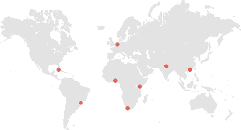Alamar is a satellite city, east of Havana, Cuba, with communist roots. Built in the 1970s, Alamar was part of the embodiment of the Revolution itself: a large-scale housing complex for Castro’s workers. Several decades later, this revolutionary dream has shown not to be resistant against the ravages of time: Alamar’s apartment blocks are in decay, the neighborhood is isolated from Havana’s city center itself and suffers from a lack of identity and a monotonous cityscape. INTI came to Havana to aid in the regeneration processes of Havana’s historic port but also aims to see into Alamar’s flaws. Nonetheless, INTI also embraces what Alamar can be proud of: the flourishing urban agriculture on the empty lots in the community and the ways the government supports these urban gardens.
At the moment of the communist Revolution (1959), the age-old city of Havana was in the middle of the process of being turned into a second Miami or Las Vegas: a metropolis of leisure, gambling and nightlife. As a tunnel was built to the east side of the historic harbor, the city expanded with modernist New Towns (Havana del’ Este, nowadays called ‘Camilo Cienfuegos’) and luxurious American-style suburbs. From 1959, Commandante Castro halted these developments and put an end to any investment in the capital, aiming to decentralize urbanization by investing in other Cuban cities. There was, however, one major urban area built literally along the lines that had been drawn by the prerevolutionary designers of the suburbs east of the old city: Alamar.
Though its urban boundaries have not been altered, Alamar has nothing in common with the early 1950s villas that pre-revolutionary designers envisioned. Castro’s policy was to replace the projected building of villa’s with that of prefab apartment blocks for the workers, built by microbrigades. By now, Alamar has 90.000 inhabitants and has found itself in an unique, yet critical position: though largely unpopular because of the low quality of housing and services, the distance to the city centre and the lack of public transport, Havana del’ Este and Alamar have acquired their own identity and role in the urban region. Not in the least because of the large urban plantations that have been made in what was planned as the urban centre of Alamar. Nowadays, in the barren zones along the main axis of the area the food for Havana is being produced – a practice that started in the ‘special period’ in the beginning of the nineties when Russian subsidies evaporated. Due to the American embargo, Cuba was no longer able to trade with any other foreign country and was thrown back to its own resources. Overnight, the country had to supply its citizens with food. Born out of necessity, Havana is one of the cities with the largest areas of urban agriculture.
This is Alamar’s most valuable feature to INTI: the unique mixture of apartment blocks and so called organiponico’s – urban gardens – are inspirational for the integration of urban farming in urban planning and practice elsewhere (e.g. Almere and Nairobi). However, this agricultural system is presently under threat. 2016 will be the year that the USA will lift the Cuban embargo and thereby enable international trade. Foreign parties will have (and take) the chance to start trade with Cuba and Cuba will be able to import goods at unprecedentedly low costs. This development is likely to endanger Cuba’s urban agriculture as buying food is easier than growing it yourself. INTI realizes the value of this system of urban farming for social and health reasons and aims to use its system of knowledge exchange to develop a strategy of professionalization.
Havana’s Harbor Development
Due to the construction of a new harbor in Mariel, a city close to Havana, which will take over Havana’s large scale transport activities, the old harbor of Havana lends itself to redevelopment: a process that has already started, but is accelerated by the recent political opening up of Cuba. The open borders of the country allow for new perspectives. One vision is that of the commercial transformation of the old harbor, picking up on where development was stopped in the 1950s and turning the city into the tourist destination it was thought to become in the pre-revolutionary years, providing cruise ship facilities, golf courses, gated communities, leisure and a vibrant nightlife.
However financially tempting this entertainment-oriented vision, there is also a strong tradition in Havana to preserve the urban heritage: the old city already became a Unesco monument in 1982. The most important challenge at hand is the transformation of the old harbor: how can this piece of urban history become an economically viable project, working in cooperation between private and public parties, while maintaining the quality and beauty of this undisturbed historic urban fabric? The harbor’s eccentric position in the city cannot be ignored in the process of redevelopment.
Ideally, the redevelopment of the harbor could fix the initial flaws in the planning of Habana del’Este and Alamar and solve both its isolation and its economic struggles. Simultaneously, the redevelopment of the harbor could be a way to provide economic opportunities for the neighborhoods in the south of Havana, which are presently unconnected to the waterfront, but would benefit from a physical and economic connection.
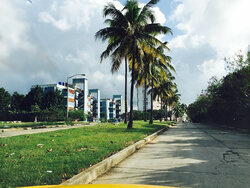
A New Town built by its residents. It may look like Plattenbau (large panel construction) but it’s not. Alamar was built with concrete and bricks by Microbrigades consisting of 20-30 factory workers who constructed the housing blocks together in order to obtain an apartment. In fact, while Alamar is very unpopular in general, the original residents are still proud of their accomplishment and claim the apartments are bigger and better than similar ones throughout Cuba. Of course, the blocks built in the eighties by prisoners are of less quality.
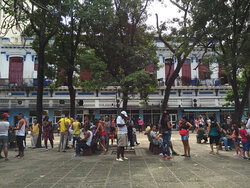
Internet is a place. In a city where Internet is expensive and largely unavailable, WiFi is actually visible in the cityscape of Havana. Squares full of people emailing and Skyping, come rain or shine, show where WiFi is available. The scarcity of Internet activates public space.
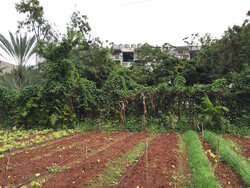
90% of vegetables are produced locally. Against the backdrop of the Alamar apartment buildings, organoponico’s are run by local groups of residents, mostly 50+. Born out of need and food scarcity, the farms have occupied all the available land that in the original masterplan was meant for collective, sports or commercial program. What will happen with this largely successful farms when the economy of Cuba opens up? Is there a way in which farming could also become popular with the younger generation?
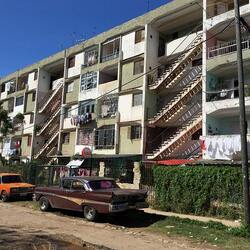
Mixing monuments with social housing. The restoration of the Plaza Vieja, the central square in Old Havana, is one of the big showcases of the Office of the Historiador of Havana, Eusebio Leal. His strategy has successfully withstood gentrification: the square attracts millions of tourists each year and still houses an elementary school, a museum, and lots of social housing on what is possibly the most attractive place in the old city. Still, with his unique and unlikely business model, the Historiador makes huge profits for the State of Cuba. The fact that residents of the social housing take their chance and offer their apartments as Casa Particular to tourists is not appreciated.



